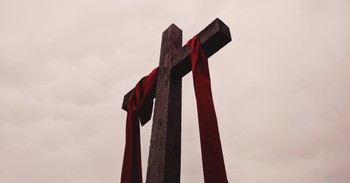Many of us may know the phrase “the cost of discipleship.” We know that Jesus indicated it wouldn’t be easy to follow him. Many people would hate Christians because of him. Did you know that someone wrote a book called The Cost of Discipleship? His name Dietrich Bonhoeffer.
We’ll dive into the person of Dietrich later, but if his name sounds familiar, you may have heard about his martyrdom in World War II at the hands of the Nazi regime.
Today, we’ll dive into the meaning of discipleship, what the book covers, and what we can learn from the life of Dietrich Bonhoeffer.
What Does Discipleship Mean?
Before diving into his book, we have to understand the discipleship in the “cost of discipleship.” Can we produce a biblical definition?
In essence, it’s Christians helping others to become Christians—or become like Christ. Jesus had disciples. For three years of ministry, he helped this group become more like him. Then, in Matthew 28, he gave them the Great Commission: to go and make disciples of all nations.
Depending on our church tradition, we may not always have a clear definition of discipleship. Some traditions may not as strongly emphasize helping one another to become more like Christ. Others have particular methods for explaining discipleship.
While methods for doing discipleship differ across different traditions and churches, it often looks like an older mentor directing someone younger in the faith on their spiritual journey.
So where does the cost come in?
We see this happening in the early church almost right away. People did not like the name of Jesus. Why? Because Jesus made deity claims. If Jesus rose from the dead, people had to live differently.
And people never like getting told to live differently.
So they persecuted Jesus’ followers to silence them. Hence, where the cost steps in.
Who Was the Author of The Cost of Discipleship?
Speaking of great cost, let’s talk about Dietrich Bonhoeffer.
Dietrich was a German theologian who lived in Berlin. He was against the Nazi regime from the moment it began in his country.
Not only did he speak out in the pulpit against Hitler, but he conspired with several others to assassinate the Fuhrer. Unfortunately, the Nazis got wind of other subversive work he was doing (helping Jews escape Germany). His activities led to his arrest and placement in a concentration camp. The Nazis executed Bonhoeffer when they discovered his part in the assassination plot. The Nazis surrendered three weeks later.
Still, despite his life being cut short, his writings have influenced Christians for decades. His most famous books are his reflections on Christian community, Life Together, and his series on the Sermon of the Mount, The Cost of Discipleship.
When Was the Cost of Discipleship Published?
The Cost of Discipleship was published in 1937. At this time in Nazi Germany, several events had occurred.
In February of that year, 2,000 prisoners were sent to concentration camps.
By July, over 50,000 people were murdered at the Nazi camps, 11,000 of those people being Jewish.
By December, German thought police had started rounding up anyone they thought would be antithetical to their regime. Their definition of “antithetical” included ethnic groups they disliked, such as the Romani (you may know them by the disparaging term “gypsies”), people with disabilities, and religious groups they disliked (such as Jehovah’s Witnesses).
As one can imagine, living in Berlin at the time… was brutal. Even speaking out against Hitler could land someone in a concentration camp. We can imagine the timidity many Germans felt. Many went along with the crowd for self-preservation.
Still, many brave souls like Dietrich fought to pursue Christian ideals (and secretly fight back against the Nazis). We can only hope that we could have the faith of someone like Dietrich when similar regimes fight against human rights.
What Are the Main Points of the Cost of Discipleship?
Let’s dive into the central premise of The Cost of Discipleship. Then we can break down some of the main points.
A recent edition of the book sums up its subject in a question: “What can the call to discipleship, the adherence to the word of Jesus, mean today to the businessman, the soldier, the laborer, or the aristocrat? What did Jesus mean to say to us?”
In other words, Dietrich sought to show how Jesus’ teachings apply to us common folk today. Many of the teachings may go over our heads because of cultural differences. After all, Jesus taught to people in an agrarian society—they lived around shepherds who kept flocks and farmers who sowed seeds, things Jesus mentioned in his illustrations. We had entered the industrialized era by the time Bonhoeffer hopped onto the scene.
Bonhoeffer hoped Christians could live ethically, consistently, with what was laid out in Scripture—not falling prey to evil powers such as the Nazis.
With this in mind, let’s dive into the book’s main points.
Dietrich breaks down the book into four sections:
Grace and Discipleship
In this section, Dietrich defines discipleship for us, what it looks like for the individual, and what it looks like in lieu of the cross. Perhaps the most famous word we’ve derived from this section is “cheap grace” versus “grace with a cost.” Essentially, cheap grace is someone preaching forgiveness but not repenting. Bonhoeffer maintained that when people talk about forgiveness but not the cost—the sanctifying process everyone who follows Christ must undergo—that person is not receiving true forgiveness. They have missed the mark. We cannot go into the world of discipleship without first understanding it and understanding grace.
You may have heard of Jesus’ most famous sermon series. If not, read about it here. This section has a lot to dissect in this section because theologians have many interpretations of the Sermon on the Mount. One thing that does seem clear is Bonhoeffer uses the Sermon of the Mount to call for unity among Christians—unified around Christ, who gave us the Sermon. It is also interesting that Bonhoeffer dedicates a whole chapter to “the enemy” when he was writing during the time of the Nazis.
The Messengers
Once Christians have been unified, we need to spread the Word. Enter the Messengers section. Here Bonhoeffer breaks down evangelism and the suffering those who spread the word will experience. This is derived from Jesus’ comment that “the harvest is plenty,” but there are few workers to till the soil (Matthew 9:37-38).
The Church of Jesus Christ and the Life of Discipleship
This section looks at the church as a whole. There is the visible church—the church we can see here now on Earth. There is also the invisible church—the church throughout history and the saints. Here Bonhoeffer also breaks down important sacraments, such as baptism, and how the sacraments fit within discipleship.
With almost 30 chapters, there’s much more to cover about Bonhoeffer’s work. One article cannot do it justice. But if you want to read his work, I highly recommend this book. It can provide a great history lesson—how a Christian sought to unify believers during the beginning of the Nazi regime, one of the evilest periods in history. Even without knowing the history, it gives some incredible lessons that Christians still need to remember today.
What Else Did Dietrich Bonhoeffer Write?
Dietrich wrote quite a few books during his time here on Earth. Here are some of his most famous ones:
Life Together. Building on his experience teaching and living at an underground seminary, Bonhoeffer considers what it looks like to live in unity as Christians.
Ethics. An unfinished but fascinating book that Bonhoeffer started in prison, which talks about what Christian ethics looked like in the modern world.
Letters and Papers from Prison. One of his final works, collecting his letters to loved ones and thoughts on various subjects—subjects like what the church will look like in a world that increasingly rejects Christianity.
Many other books attributed to Bonhoeffer are compilations of his works—his sermons, short stories, etc. You can find a sampling of those works here.
Living for Christ isn’t always easy. Bonhoeffer proved you can stand up to great evils when others succumb to peer pressure.
Bonhoeffer’s life often reminds me of Daniel’s friends in Daniel 3. When all others succumbed to great evils, they continued to stand strong in their beliefs.
Even though Dietrich Bonhoeffer’s life was cut short, we can still learn from his legacy and writings today.
Further Reading:
Generation Z, the Holocaust, and the Gospel
Why Is the Holocaust Being Forgotten?
10 Inspiring Movies about Martyrs
Dietrich Bonhoeffer and Nazi Germany
10 Holocaust Movies for Holocaust Remembrance Day
7 Things We Must Never Forget about the Holocaust
Remembering Dietrich Bonhoeffer 70 Years Later
Photo Credit: Getty Images/RoterPanther
Hope Bolinger is an acquisitions editor at End Game Press, book editor for hire, and the author of almost 30 books. More than 1500 of her works have been featured in various publications. Check out her books at hopebolinger.com for clean books in most genres, great for adults and kids. Check out her editing profile at Reedsy.com to find out about hiring her for your next book project.



